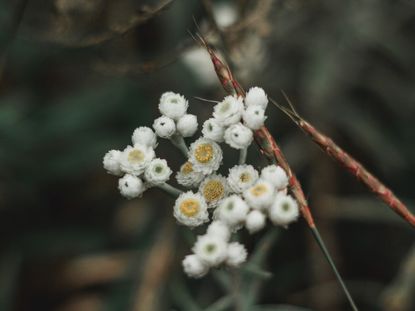Growing Pearly Everlasting Plants In The Garden


Pearly everlasting plants are interesting specimens that grow as wildflowers in some areas of the United States. Growing pearly everlasting is simple. It prefers soil that is dry and weather that is hot. Once you've learned how to take care of pearly everlasting and the range of pearly everlasting uses, you may want to include it in several areas of the landscape.
Growing Pearly Everlasting
Known botanically as Anaphalis margaritacea, pearly everlasting plants are native to much of northern and western parts of the United States and grow in Alaska and Canada as well. Small white flowers grow on pearly everlasting-- clusters of tight buds with yellow centers resemble pearls on a string, or in a cluster. Foliage of pearly everlasting plants is grayish white too, with small fuzzy leaves adorning this unusual specimen. In some areas, the plants are considered a weed, so make sure you are able to take care of pearly everlasting in a manner to avoid future pearly everlasting problems. Pearly everlasting plants are drought tolerant. Watering causes the stolons to spread, so if you want just a small stand of the plant, withhold water and don't fertilize. This plant will easily colonize without fertilization. In most cases, fertilizing will cause pearly everlasting problems such as unwanted spreading. Pearly everlasting wildflowers can be started from seeds or small plants. The plant is adaptable to sunlight, growing equally well in full to partial sun, but plant it in soil that is lean and dries out well. Blooms are long-lasting and attractive when growing in meadows, woodlands, or controlled home landscape settings. Try the variety Anaphalis triplinervis, which only spreads 6 inches (15 cm.) out.
Pearly Everlasting Uses
When growing pearly everlasting, use this long-lasting plant in cut flower arrangements. It can also be harvested and hung upside down to use as part of a long-lasting dried arrangement. Growing pearly everlasting is easy-- just remember to keep it under control by removing plants if necessary. Withhold water as a means of control and use the plant in indoor arrangements when they must be removed from the garden. Reaching 1 to 3 feet (61-91 cm.) in height, growing pearly everlasting in containers is feasible for those who don't desire the spread of the plant. It is hardy in USDA zones 3 to 8.
Gardening tips, videos, info and more delivered right to your inbox!
Sign up for the Gardening Know How newsletter today and receive a free download of our most popular eBook "How to Grow Delicious Tomatoes."

Becca Badgett was a regular contributor to Gardening Know How for ten years. Co-author of the book How to Grow an EMERGENCY Garden, Becca specializes in succulent and cactus gardening.
-
 10 Best Apartment Plants To Turn Your Small Space Into An Oasis
10 Best Apartment Plants To Turn Your Small Space Into An OasisThe best apartment plants can lend an ambience of the tropics, brighten up a space, or add a touch of drama, and turn an apartment into a relaxing oasis.
By Amy Grant
-
 Grow a Bathroom Oasis: 8 Best Bathroom Plants With No Light or Low Light
Grow a Bathroom Oasis: 8 Best Bathroom Plants With No Light or Low LightSome apartment dwellers grow the best bathroom plants with no light or low light. Read how one of our favorite plant lovers does it in the big city.
By Teo Spengler